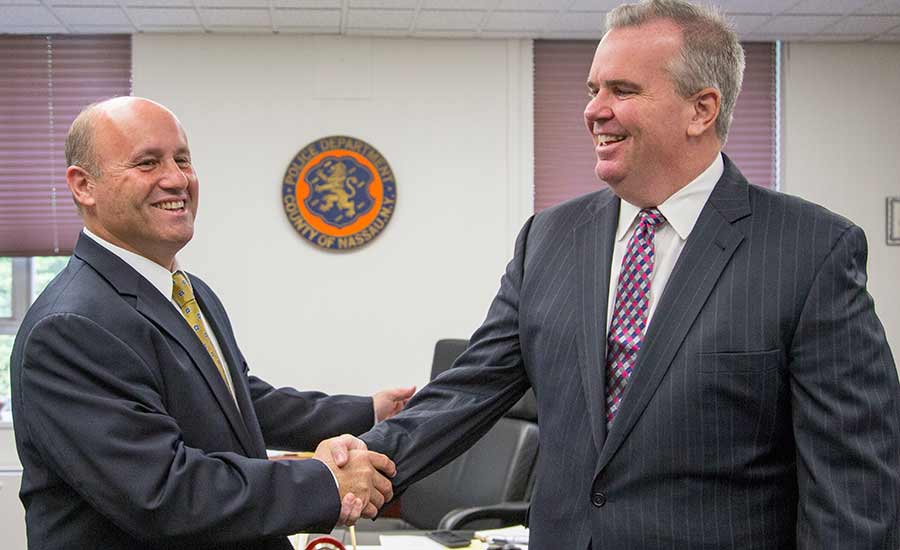Nassau’s Acting Top Cop Retiring: What You Need to Know
Nassau’s top cop, acting Police Commissioner Thomas Krumpter, is retiring, effective July 20.
Krumpter was named acting commissioner of the department in 2014 — a tenure that included the controversial consolidation of police precincts in a cost-cutting effort and a union-blocked move to usher in body cameras. But Nassau County Executive Edward Mangano never formally nominated him to be top cop, which would have required Krumpter to face public scrutiny before the Nassau County Legislature — which votes on all commissioner-level appointments.
His retirement comes after 25 years in the department.
.@NassauCountyPD Acting Commissioner Krumpter on his retirement: "You just get to a point when it's time." pic.twitter.com/dheLmegUO1
— Nicole Fuller (@nicolefuller) June 5, 2017
A Long Island native
Krumpter grew up in South Huntington and graduated from St. Anthony’s High School in 1985, the same year his father retired from the Nassau police department.
He served as a U.S. Marine before working as a New York City Housing Authority police officer from 1989 to 1992, when he joined the Nassau County Police Department.

Krumpter announces increased patrols in communities in 2016. Photo by Howard Schnapp.
He earned a bachelor’s degree in accounting from SUNY Old Westbury in 2005 and a master’s in criminal justice from the University of Cincinnati in 2013. He is married with two sons.
Though he has been in talks to become the chief of the Lloyd Harbor Village Police Department, Krumpter said Monday he is juggling several job opportunities, both in government and the private sector.
State of the department
Krumpter has sought to address some of the thorniest issues facing law enforcement recently, from a national wave of anti-police feelings to the surge in gang-related killings across Long Island. He frequently butted heads with the previous head of the police union on issues including body cameras for officers.
Precinct consolidation
One of the department’s most dramatic changes — the precinct merger plan — came before Krumpter’s time in the top spot, though he was the point person on it as first deputy commissioner. The plan was approved in March 2012 when Thomas Dale was commissioner. It called for eight precincts to be consolidated into four, with the closed precincts converted into lighter-staffed “community policing centers.” In the end, only part of the plan was enacted.

Krumpter at the grand opening of the new First Precinct in Baldwin. Photo by J. Conrad Williams Jr.
The proposal was touted by Mangano and Krumpter who said it would save $20 million annually. It was the subject of scores of public meetings, during which critics charged the mergers would result in more crime, slower response times and increased police overtime. Police officials countered that the same number of police would be on patrol and crime would not spike.
Combating the heroin problem
The police department launched its heroin task force in 2015, shifting eight detectives to its Narcotics Unit. The detectives were tasked with gathering intelligence on heroin dealers and making arrests. In 2016, Krumpter joined Suffolk County Police Commissioner Timothy Sini in launching a joint heroin task force to try to trace the origins of every overdose, officials said. Detectives from each county and an intelligence analyst were assigned to the unit full time.
Mangano touted it as one of the tenets of Krumpter’s time as commissioner. “With the formation of a Joint Heroin Task Force, we have combined resources with Federal, State and local law enforcement partners to track down the sources of fatal heroin overdoses. We have arrested hundreds of drug dealers, seized firearms and taken thousands of glassines of heroin and pain pills off our streets,” he said in a statement.
Use-of-force policy
In 2016, the police department revamped its use-of-force policy, urging officers to use de-escalation methods rather than physical force. The policy also expanded and tracked the incidents involving physical force reviewed by top brass and limited the use of the controversial chokehold.

Krumpter discusses the new use-of-force policy in July 2016. Photo by Howard Schnapp.
The policy tweaks came about two years after the department embarked on the first major overhaul of its policy in more than three decades in the wake of a pair of high-profile shootings involving Nassau officers.
A question about morale
Earlier this year, Krumpter and newly elected Nassau Police Benevolent Association President James McDermott traded public remarks about officer morale in the department.
In response to comments Krumpter made to Newsday, in which he said that officers who don’t like their jobs should quit, McDermott said that morale was at a low point and that the commissioner was not in a position to know how officers view their jobs. McDermott pointed to a wage freeze, loss of longevity pay, and poor work conditions in some precincts.
Krumpter pointed to the average salary of $125,000 to $130,000 a year, and said “if someone can’t be happy with that on the Nassau police department, I am not sure they’ll be happy with any police department.”
Officer fired
In May 2014, early into Krumpter’s tenure as commissioner, the police department fired Officer Anthony DiLeonardo, who was off-duty and not in uniform when he shot a retreating, unarmed cabdriver in Huntington Station after a night of drinking with another cop.

June 23, 2013: How Newsday covered the story.
DiLeonardo, who police internal affairs investigators found recklessly escalated a roadside dispute, was never suspended after the Feb. 27, 2011, incident in which he fired his service weapon five times at cabbie Thomas Moroughan. An internal affairs investigation concluded in 2012 that DiLeonardo be brought up on 19 departmental charges, but disciplinary actions against the officer did not begin until after Newsday reported about the lawsuit.
Krumpter called DiLeonardo’s conduct a “breach of public trust” and said it would “not be tolerated by the Nassau County Police Department.”
Record crime lows
Under Krumpter’s watch, the overall crime rate in Nassau County in 2016 dropped to a new all-time low as crimes in almost all categories — including homicides and shootings — fell slightly compared with 2015, department statistics show. Krumpter credited the use of increased technology and more aggressive policing for the drop.
How the record 2016 numbers compared with the 2015 numbers, which were also low:

1.64%
Decrease in overall crime

8.7%
Decrease in violent crime, including homicide, rape and shootings

16.78%
Decrease in residential burglaries
Krumpter said in March that the department would maintain those numbers with a plan to add hundreds of new license plate readers and gunshot detection devices to county streets, and expand the network of paid informants.
What’s next?
Deputy Commissioner Patrick Ryder will serve as acting commissioner after Krumpter retires, Mangano announced.
Ryder was appointed to his current position on Jan. 1, 2017, the top promotion among a slew to replace top brass in the department after retirements in 2016 and 2015.

Krumpter and Patrick Ryder after Krumpter’s retirement announcement. Photo by Howard Schnapp
Ryder was previously a detective sergeant and was the commanding officer of the department’s Asset Forfeiture and Intelligence Unit. By taking on a civilian post as deputy commissioner, Ryder saw his salary decrease from the base of $273,709 in 2016 to $249,425 — a $23,284 pay cut.
Brian Hoesl, president of the Superior Officers Association, the union representing those at the ranks of captain and above, said while he has “great respect” for Ryder, whom he called “talented,” he questioned Krumpter on his decision to appoint the detective sergeant to the deputy commissioner post, bypassing several higher-ranking officers.
The move was not unprecedented, however, as lieutenants and sergeants have been promoted to deputy commissioner three times previously, officials said.
Krumpter defended his choice, pointing to Ryder’s expertise in asset forfeiture, which has seized about $141 million from illegal activity that has been used to fund a host of equipment purchases and initiatives. He said Ryder “brings a skill set to the table that is unique.”



